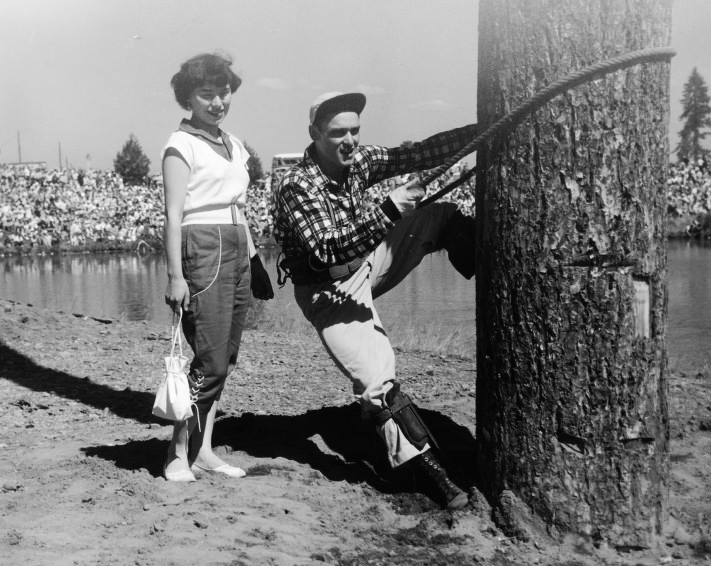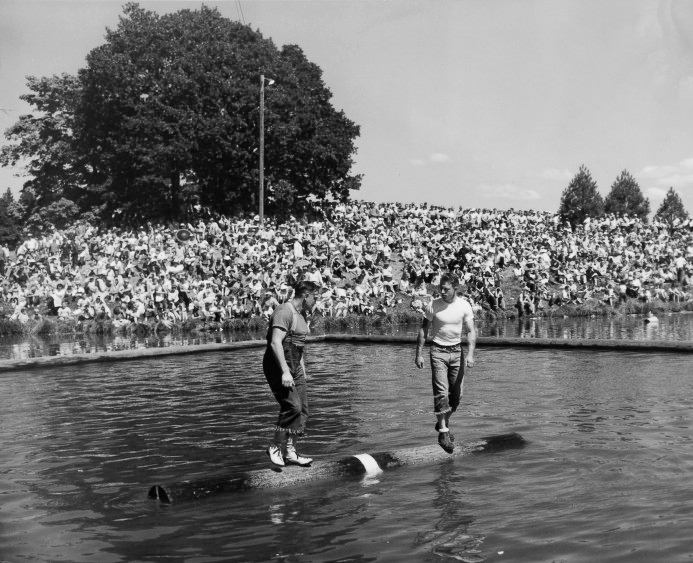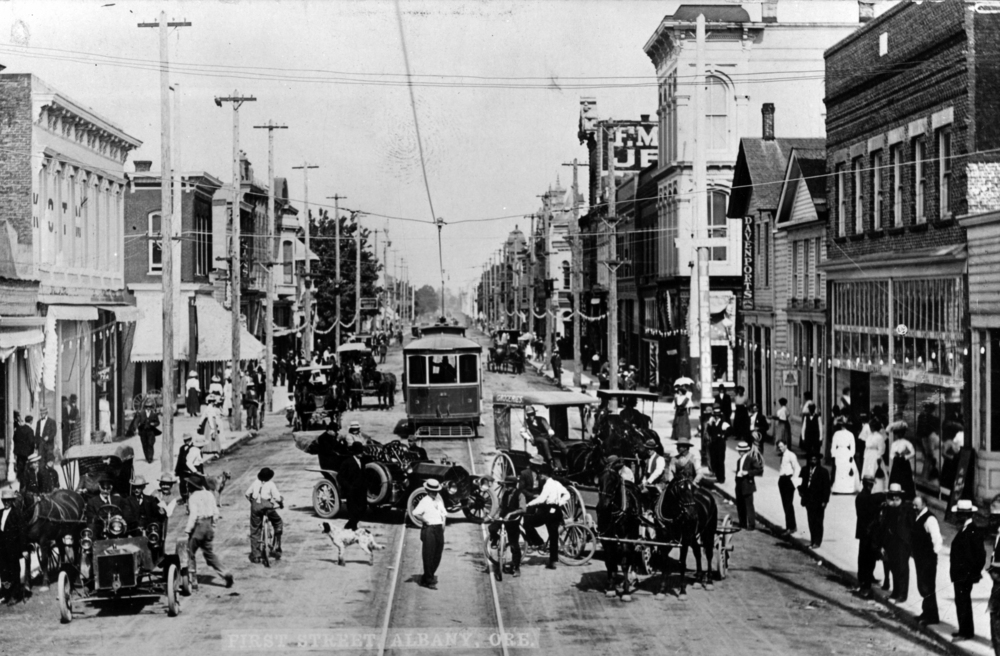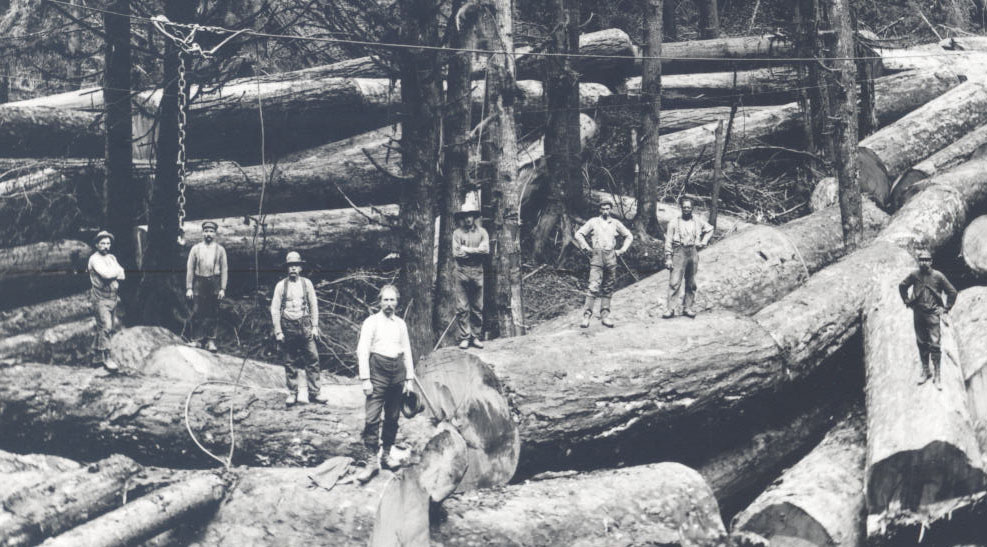From 1941 through 2000, the Albany Timber Carnival was held almost every year in early July to celebrate Independence Day and to focus on the region's timber industry. In 1941, what was called the Central Willamette Timber Carnival was managed by the Albany Chamber of Commerce. After a four-year hiatus because of World War II, the Albany Junior Chamber of Commerce (Jaycees) adopted the carnival as its principal service project. That effort resulted in the Timber Carnival's selection in 1947, 1948, and 1949 as the outstanding Jaycee project in the nation for cities with a population under 25,000.
From its beginning, the Timber Carnival had four principal elements: logging sports competition, royal court, parade, and fireworks display. The Jaycees recruited financial sponsors for the fireworks and parade but otherwise funded the show themselves.
The royal court typically consisted of princesses from Albany and nearby towns. While successful sales of Timber Carnival buttons were not the sole criterion, the queen was usually the princess who sold the most buttons.
The marching bands, drill teams, floats, and log trucks that made up the parade manifested Timber Carnival themes of patriotism, local business promotion, and tributes to the forest products industry. Each Carnival concluded with fireworks.
While the court, parade, and fireworks remained essentially unchanged throughout the Carnival's history, the logging competition expanded over the years as new events were added and women contestants were included. In the 1960s, competitors from Australia introduced traditional chopping events from that country. Power chain-sawing competitions and skidder races in the 1970s reflected changes in logging practices after World War II.
Harold Johnson, Mervin Lentz, Ron Hartill, brothers Ron and Larry Downing, Melvin Lentz, Guy German, David Bolstad, and Jason Wynyard were foremost among the many people who competed at the Timber Carnival. Over the years, they set many world records in the sawing, chopping, and climbing events.
Women's log rolling became an official event in 1960, and Jack-and-Jill bucking was added in 1968. Occasionally, women competed against the men in axe throwing and power sawing. In the late 1990s, more chopping and sawing events were opened to women.
Through 1958, the logging sports and fireworks were staged at Waverly Lake, but the lake was state property and had limitations that hampered the growth of the celebration. In 1959, the carnival moved to Timber Linn Lake, a city-owned property that the Jaycees developed specifically to accommodate the event.
The Timber Carnival was a popular summer attraction in the Willamette Valley and was one of the nation's premier celebrations of the timber industry. Over the event's history, it drew an estimated million and a half people. Local men and women worked diligently to make the event a success, producing a celebration that united the community and contributed to local businesses.
As the character of the town changed and the importance of timber to Albany's economy declined, support for the Timber Carnival ebbed. The last Carnival was held in 2000.
-
![Albany Timber Carnival, 1950s.]()
Albany Timber Carnival, 1950s, 2.
Albany Timber Carnival, 1950s. Oreg. State Univ. Archives, Gifford Photo Collec., P 218 SG 4 Series II
-
![Albany Timber Carnival, 1950s.]()
Albany Timber Carnival, 1950s, 1.
Albany Timber Carnival, 1950s. Oreg. State Univ. Archives, Gifford Photo Collec., P 218 SG 4 Series II
Related Entries
-
![Albany]()
Albany
The Albany area—situated at the confluence of the Calapooia and Willame…
-
![Timber Industry]()
Timber Industry
Since the 1880s, long before the mythical Paul Bunyan roamed the Northw…
Related Historical Records
Map This on the Oregon History WayFinder
The Oregon History Wayfinder is an interactive map that identifies significant places, people, and events in Oregon history.
Further Reading
Loy, Edward. Tim Burr! An Illustrated History of the World Championship Albany Timber Carnival. Albany, Ore.: Albany Regional Museum, 2010.




